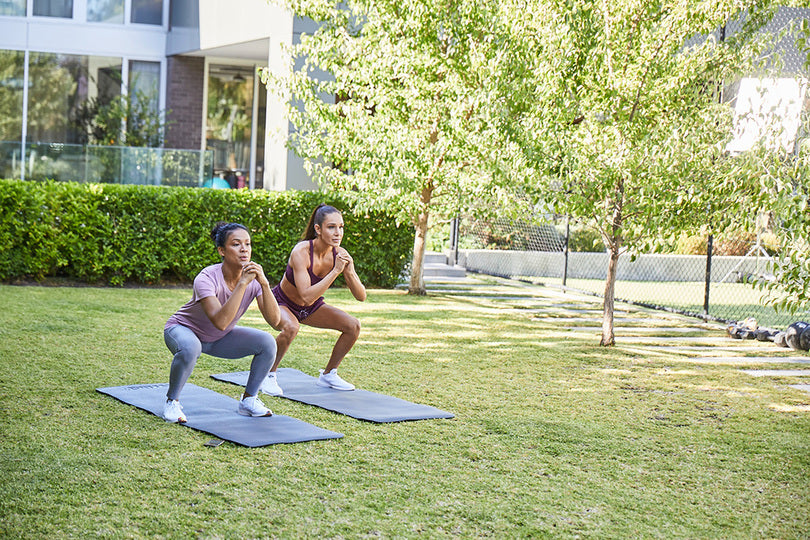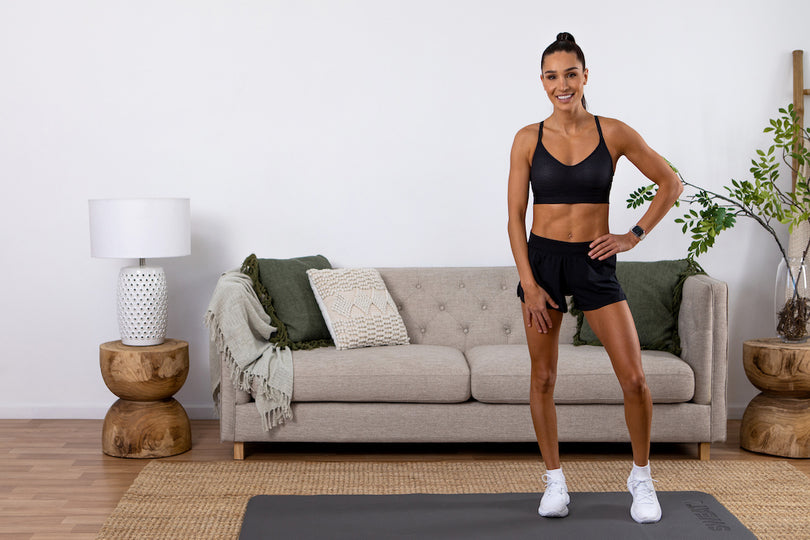How To Modify The Hardest Exercises In High Intensity with Kayla


Starting out as a High Intensity with Kayla (formerly the BBG program) beginner is hard — I’ve even been there. I had to modify a LOT of exercises after my pregnancy that I would not normally have given a second thought about. That’s when I KNEW I had to create my High Intensity with Kayla Beginner program.
But what do you do if you are still finding some of the exercises tough, even AFTER you’ve built up your baseline fitness?
Below I’ll show you how you can continue with High Intensity with Kayla like a BOSS and modify the exercises you find the HARDEST to complete.
How to modify the hardest High Intensity with Kayla exercises
A lot of the toughest exercises in my programs are plyometric and there’s that one exercise we all dread. ‘Death by burpees’ is a common phrase I always hear, and I know a lot of you ladies agree with.
Whether it’s because you don’t have the strength and fitness yet, the exercise is too hard, or you think you might be doing any of the exercises in my program wrong, it’s okay to take a step back and modify when you need to.
It’s SO important to have good form for any exercise you do so that you can get the most out of your workout, and more importantly, avoid the risk of injury.
Here are the nine hardest exercises in High Intensity with Kayla and how to make them easier. I also have a new Low Impact with Kayla program which doesn't include any of the jumping exercises.
Ab bikes alternative: Modified ab bikes
If you’ve ever attended one of my bootcamps, you would know that ab bikes are one of my favourite exercises to work your core!
Ab bikes are a great exercise to help you build your rectus abdominus, or six-pack muscle, and also use the obliques. Below I demonstrate how to modify ab bikes using a chair, if you find the full exercise too much.
- Place a chair in front of you. Begin lying face up on a yoga mat, with your feet elevated on the chair and hands behind your ears. Engage your abdominal muscles by drawing your belly button in towards your spine, and gently raise your head and shoulders off the mat. This is your starting position.
- Inhale to prepare. Exhale and, while stabilising through your abdominals, release your right foot off the chair and draw your knee in towards you. At the same time, twist your torso to bring your left elbow towards your right knee. You should feel tension in your abdominals throughout the movement.
- Inhale and lower your leg and arm to return to the starting position.
Alternate between sides for the specified number of repetitions or time.
Russian twist alternative: Heel tap
You need to engage your core the whole time in a Russian twist. When done properly, it is a great exercise to target your obliques.
Heel taps work the same muscle group, but more of your torso is on the ground for support. This can help to take some of the pressure from your core.
- Start by lying flat on your back on a yoga mat with your arms by your sides. Bend your knees and position your feet firmly on the mat hip-width apart. Slowly lift your head and shoulder blades and arms off the floor and engage your abdominal muscles by drawing your belly button in towards your spine. This is your starting position.
- Bend your torso to the right to allow your right hand to touch your right ankle.
- Return to starting position and bend your torso to the left to allow your left hand to touch your left ankle.
Continue alternating between right and left for the specified number of repetitions, inhaling for four repetitions and exhaling for four repetitions.
Push-up alternative: Push-up (knees)
It is totally NORMAL to struggle with push-ups on your toes if you are a beginner.
Start off with push-ups on your knees until you build your upper body strength. You can then gradually work towards including even one or two full push-ups in your workout until you can eventually complete all given reps.
- Place both hands on the mat slightly further than shoulder-width apart, feet together on the mat behind you while resting on your knees. This is your starting position.
- Inhale. While maintaining a neutral spine, bend your elbows and lower your torso towards the mat until your arms for two 90-degree angles.
- Exhale. Push through your chest and extend your elbows to lift your body back into the starting position.
Repeat for the specified number of repetitions.
Drop push-up alternative: Lay-down push-up (knees)
There’s no question that push-ups are hard and require a LOT of upper body strength. It’s important to perfect your push-up before attempting any variations.
If you find drop push-ups too difficult, a lay-down push-up on your knees can help to break down the movement.
- Place both hands on the mat slightly further than shoulder-width apart, and your feet together on the mat behind you, resting on the balls of your feet. This is your starting position.
- Inhale. While maintaining a neutral spine, bend your elbows and lower your torso to the mat.
- Extend both arms out in front of you.
Bring your arms in towards your body and place your hands on the mat on either side of your chest. - Exhale. Push through your chest and extend your elbows to lift your body back into the starting position.
Repeat for the specified number of repetitions.
Outward snap jump alternative: In and out plank
If you struggle to keep your core activated and find that your hips drop toward the floor during this exercise, then try removing the jump.
In and out planks still require you to focus on keeping your core engaged and hips in line, but you’ll step out the movement instead.
- Start by placing your forearms (wrist to elbow) firmly on the mat, ensuring that your elbows are directly below your shoulders. Extend both legs behind you and elevate your hips off the mat, resting on the balls of your feet, with your feet together. Brace your abdominals and ensure that your spine remains in a neutral position.
- While keeping your hips as still as possible, step your left foot outwards slightly, followed by your right foot, so that your feet are hip-width apart.
- While keeping your hips as still as possible, step your left foot inwards, followed by your right foot, to return to the starting position.
Repeat for the specified amount of time.
Rebound lunge alternative: Static lunge
The complexity of stepping forwards and backwards in a rebound lunge requires a lot of stability.
If you aren’t confident with this movement, you can substitute for a static lunge instead. Static lunges are suitable for beginners as they have a more constant base of support.
- Plant both feet on the floor in a split stance with your left leg forward and your right leg back, ensuring that your feet are shoulder-width apart. This is your starting position.
- Inhale. Bend both knees to approximately 90 degrees. If done correctly, your front knee should be aligned with your ankle and your back knee should be hovering just off the floor.
- Exhale. Extend both knees to return to the starting position.
Complete half of the specified number of repetitions on the same side, before completing the remaining repetitions on the other side.
Jump lunge alternative: Step-up
If done incorrectly, lunges can place unwanted stress on your knees, ankles and hips. When you add a jump into the movement, you can imagine the additional stress on the joints and impact this can have.
Jumping exercises can challenge your balance too, so improving your core strength can help with stabilisation.
To work your way up to a jump lunge, you can substitute for a step-up using a step, chair or bench, until you feel confident with progressing.
A step-up is a great way to build strength in the glutes and quads which can help you work towards a jump lunge. Here’s how to do it.
- Place a chair in front of you. Plant your left foot on the chair and right foot on the floor, ensuring that they are hip-width apart. This is your starting position.
- Inhale. Exhale as you push through the heel of your left foot to stand up on the chair, keeping your right leg extended beneath your hips. You should feel the weight through your left quads and glutes.
- Inhale as you lower your right foot back to the floor with control.
- Repeat for the specified number of repetitions or time on each side.
Jump squat alternative: Goblet squat
To lessen the impact on your knees, you can substitute a jump squat for a goblet squat.
The added weight from a kettlebell not only means that your lower body is working harder, but also requires you to use more of your core. This is a great way to intensify your squat without jumping.
- Holding a kettlebell with both hands directly in front of your chest, plant both feet on the floor slightly further than shoulder-width apart. This is your starting position.
- Inhale. Looking straight ahead, bend at both the hips and knees, ensuring that your knees point towards your toes. Continue bending your knees until your upper legs are parallel with the floor, ensuring that your back remains between a 45- to 90-degree angle to your hips.
- Exhale. Push through your heels and extend your knees to return to the starting position.
Repeat for the specified number of repetitions.
Burpee alternative: Modified burpee
Burpees work your ENTIRE body, so naturally they are going to require more effort and will leave you feeling out of breath.
To make a burpee easier, you can do a modified burpee with a chair, and simply step out each part of the movement to reduce the ‘drop down’ element.
- Place a chair directly in front of you with the seat facing towards you. Standing one step away from the chair, plant both feet on the mat shoulder-width apart. This is your starting position.
- Bend at both the hips and knees to place your hands on the chair, ensuring that your spine remains in a neutral position.
- Inhale. Step your feet backwards, one at a time, so that your legs are completely extended behind you, resting on the balls of your feet. Your body should be in one straight line from your head to your heels.
- Step both of your feet forwards one at a time, once again, ensuring that your feet remain shoulder-width apart.
- Exhale. Extend your legs to stand up tall and reach your arms above your head. As you reach the top of your stance, press into the balls of your feet to raise your heels off the ground.
- Inhale. Lower your arms and heels to return to the starting position.
Repeat for the specified number of repetitions.
Get your workout done with these exercise alternatives
Don’t let difficult exercises stop you from working towards your fitness goals.
When you listen to your body and make modifications where needed, you can overcome your barriers to starting and get closer to reaching them.
Progress takes hard work, but with the right mindset and perseverance you CAN get there!
Are there any other exercise modifications you want to see? Let me know in the comments!
* Disclaimer: This blog post is not intended to replace the advice of a medical professional. The above information should not be used to diagnose, treat, or prevent any disease or medical condition. Please consult your doctor before making any changes to your diet, sleep methods, daily activity, or fitness routine. Sweat assumes no responsibility for any personal injury or damage sustained by any recommendations, opinions, or advice given in this article.




<#= c.user.username #><#= moment(c.created_at * 1000).fromNow() #>
<#= c.html_body #> <# if (c.images) { #>
<# } #>